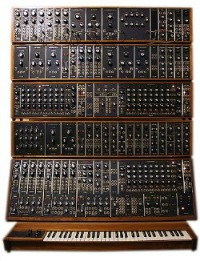Jonathan L. Friedmann, Ph.D.
In the 1960s, German-American composer Gershon Kingsley shifted his energies to electronic music. He was among the first to experiment with the Moog synthesizer (invented by Bob Moog in 1963), recording two albums with fellow electro-musician Jean-Jacques Perrey (The In Sound from Way Out! 1966 and Kaleidoscopic Variations, 1967) and a solo album, Music to Moog By (1969), featuring the synthpop classic “Popcorn.” Kingsley was drawn to electronic music for two reasons: it promised seemingly infinite sound options, and it gave composers complete creative control. He told Harry Reasoner in a 1970 CBS interview: “Instead of going through the process of first conceiving the idea, then orchestrating it, then having it played on an instrument, now a musical work can be created entirely in the studio environment….[A] composer can now function the same way as a painter or a sculptor.”
Electronic music in those early days was gruelingly hands-on. The Moog comprised a keyboard and a set of speakers connected to a refrigerator-size consul cluttered with dials, knobs, meters, and patch cords. A pressed key sent an electronic signal to the console, which “synthesized” a particular sound. The instrument was monophonic—only one note could be played at a time—meaning that chords, counterpoint, and harmony were achieved through overlaying multiple tracks. It was a tedious, highly skilled, and labor-intensive undertaking.
As technologies advanced, electronic music became further and further removed from the manual interaction of player and instrument. Music was now programmable, automated, and easily rearranged. The performance was unhindered by the limits of human breath, endurance, or dexterity. The sonic palette was endless and undefined, and tonal possibilities—note bending, durations, microtones, pitch range—far exceeded the capacity of organic instruments (those classified in the original Hornbostel–Sachs system as idiophones, membranophones, chordophones, and aerophones). These properties combined to disassociate electronic music from the natural world.
The aesthetic appeal of music divorced from a naturalistic backdrop has parallel in the “imaginative geography” of cities, where clear borders separate ordered human civilization from the untamed wild. Cities exert human dominion: the permission of certain forms of nature to exist in certain places within a human-centered environment. As Colin Jerolmack, author of the paper “How Pigeons Became Rats: The Cultural-Spatial Logic of Problem Animals,” says: “We cut out little squares in the concrete, and that’s where the trees belong. We don’t like it when grass and weeds begin to grow through cracks in the sidewalks, because that’s nature breaking out of those boundaries that we want to keep it in.”
Implicitly or explicitly, a principle of “perfecting” motivates bifurcated cityscapes and nature-eschewing electronic sounds. In the conventional scheme of human progress, there is a movement away from uncontrolled habitats to manicured environs. At first, sounds emanating from animals and the atmosphere were a major source of musical inspiration. Human beings mimicked the noises of insects, the pattering of rain, the calls of birds, and other non-human sounds. Over time, human music developed its own logic, techniques, conventions, and instruments, and became a self-imitative art form. The resulting styles and sonorities increase our distance from music’s evolutionary origins.
An early critic of this separation was French Benedictine monk Antoine Augustin Calmet. In a 1723 treatise, Dissertations sur la poésie et la musique des Anciens en général et des Hébreux en particulier, he called out the “false notion that the world develops toward greater and greater perfection and that our century is much more enlightened and cultured than previous centuries.” As if predicting developments that would lead to electronic music, Calmet wrote: “Many believe that the simplicity of ancient music was an imperfection. I think, on the contrary, that it contributed to its perfection. The more one approaches nature, the more one approaches the beautiful and the perfect.”
Visit Jonathan’s website to keep up on his latest endeavors, browse his book and article archives, and listen to sample compositions.
